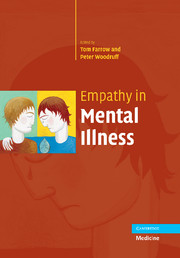Book contents
- Frontmatter
- Contents
- Foreword
- List of contributors
- Part I ‘Dysempathy’ in psychiatric samples
- Part II Empathy and related concepts in health
- Part III Empathy models, regulation and measurement of empathy
- 21 Balancing the empathy expense account: strategies for regulating empathic response
- 22 Empathic accuracy: measurement and potential clinical applications
- 23 A perception-action model for empathy
- 24 The Shared Manifold Hypothesis: embodied simulation and its role in empathy and social cognition
- 25 Using literature and the arts to develop empathy in medical students
- Index
25 - Using literature and the arts to develop empathy in medical students
from Part III - Empathy models, regulation and measurement of empathy
Published online by Cambridge University Press: 17 August 2009
- Frontmatter
- Contents
- Foreword
- List of contributors
- Part I ‘Dysempathy’ in psychiatric samples
- Part II Empathy and related concepts in health
- Part III Empathy models, regulation and measurement of empathy
- 21 Balancing the empathy expense account: strategies for regulating empathic response
- 22 Empathic accuracy: measurement and potential clinical applications
- 23 A perception-action model for empathy
- 24 The Shared Manifold Hypothesis: embodied simulation and its role in empathy and social cognition
- 25 Using literature and the arts to develop empathy in medical students
- Index
Summary
The problematic role of empathy in medicine
Medicine has had a mixed history where empathy is concerned. Although there is a tradition stretching from Hippocrates through to the current epoch of sympathy and compassion as defining qualities of medical professionalism, modern medicine has been dominated by a reductive, rationalist approach to clinical practice (Halpern, 2003). The modernist framing of professionalism engendered by this perspective presumes that impersonality, neutrality and detachment are needed to achieve objective medical care that does not favour one patient over another. In this view, the metaphor of medicine as science predominates, and the rationalist attributes of the successful scientist are transferred wholesale to the physician. Less often stated but also influential to this line of thinking is the assumption that allowing oneself feeling for patients can be emotionally overwhelming and leads to exhaustion and burn-out.
In terms of empathy, these conceptualizations have led either to its downgrading, culminating in the call for a ‘de-empathization’ of medicine in order to enable physicians to make sound, scientifically based medical decisions (Landau, 1993), or for a restricted definition of empathy as essentially a cognitive process based on the achievement of a purely logical understanding of the other. As an outgrowth of this position, medical school curricula now routinely attempt to teach empathy to students as a set of cognitive and behavioural skills (Winefield & Chur-Hansen, 2000).
- Type
- Chapter
- Information
- Empathy in Mental Illness , pp. 473 - 494Publisher: Cambridge University PressPrint publication year: 2007
- 1
- Cited by



